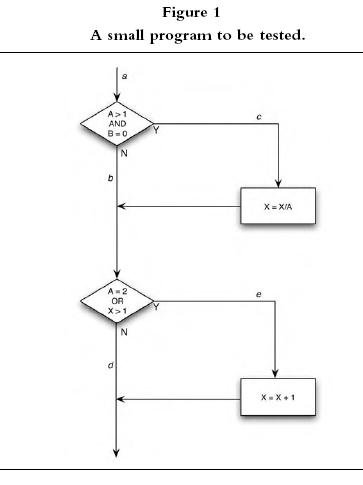|
Logic Coverage testing
White-box testing is concerned with the
degree to which test cases exercise or cover the logic (source
code) of the program. The ultimate white-box test is the
execution of every path in the program, but complete path
testing is not a realistic goal for a program with loops.
If you back completely away from path
testing, it may seem that a worthy goal would be to execute
every statement in the program at least once. Unfortunately,
this is a weak criterion for a reasonable white-box test. This
concept is illustrated in Figure 1. Assume that Figure 4.1
represents a small program to be tested. The equivalent Java
code snippet follows:
public void foo(int a, int b,
int x) {
if (a>1 && b==0)
{x=x/a;}
if (a==2 || x>1) {x=x+1;}}
You could execute every statement by writing
a single test case that traverses path ace. That is, by
setting A=2, B=0, and X=3 at point a, every statement would be
executed once (actually, X could be assigned any value).
Unfortunately, this criterion is a rather
poor one. For instance, perhaps the first decision should be
an or rather than an and. If so, this error would go
undetected. Perhaps the second decision should have stated
X>0; this error would not be detected. Also, there is a
path through the program in which X goes unchanged (the path
abd). If this were an error, it would go undetected. In other
words, the statementcoverage criterion is so weak that it
generally is useless.
A stronger logic-coverage criterion is known
as decision coverage or branch coverage. This criterion states
that you must write enough test cases that each decision has a
true and a false outcome at least once. In other words, each
branch direction must be traversed at least once. Examples of
branch or decision statements are switch, do-while, and
if-else statements. Multiway GOTO statements qualify in some
programming languages such as FORTRAN.
Decision coverage usually can satisfy
statement coverage. Since every statement is on some subpath
emanating either from a branch statement or from the entry
point of the program, every statement must be executed if
every branch direction is executed. However, there are at
least three exceptions:
- Programs with no decisions.
- Programs or subroutines/methods with multiple entry
points. A given statement might be executed only if the
program is entered at a particular entry point.
- Statements within ON-units. Traversing every branch
direction will not necessarily cause all ON-units to be
executed.

|